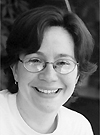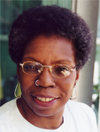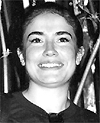|
by Jenny Coyle
Cancer Alley | Turkey Creek
Movement within a movement gains ground in the Club.
Sammy James, a Navajo medicine man, prayed aloud in his native tongue, weeping through his words at times.
Elaine Purkie strummed her guitar and sang a from-the-gut Appalachian fight song about coal mining and union might.
Balinda Moore, an African-American pastor from Tennessee, shared the story of how in her search for a new pet she phoned a woman who'd advertised her dog in the newspaper, and listened in shock as the woman bragged, "He's a good watch-dog - he especially loves to bark at niggers."
This was a Sierra Club meeting. Held in New Orleans in May, it was, in many ways, like the average Club gathering. Participants sat in a circle of folding chairs. The moderator worked from an agenda and used a flip chart. Nearby on a wooden table were piles of brochures and newsletters, postcards to sign and T-shirts to buy.
But in the middle of the room was a candle - the same candle that burned at the last gathering of organizers, activists and community partners in the Sierra Club's Environmental Justice Program. And each person held a candle lit from the candle in the center. The faces of those in the room were very light, very dark and everything in between.
 |
The EJ program is like no other in the Club. Its activists are dedicated to fighting for a clean and healthy environment for people of color and others whose communities are disproportionately targeted by polluting industries. In a sense it's a movement within a movement - and it is growing as more volunteers, more chapters, more community groups join the circle. |
Denise Hoffner-Brodsky |
|
Consider this:
Hired in 1993, John McCown, the Club's national Environmental Justice Program coordinator, based in Atlanta, Ga., remained the lone employee dedicated to EJ work until 2000, when organizers were added in Detroit, Los Angeles, Memphis and Washington, D.C. Two more will be hired this year, two more in 2002 and two more in 2003. The program is the only one in the Sierra Club to have an attorney dedicated entirely to its work: Denise Hoffner-Brodsky joined the Club's legal team in June. Environmental Public Education Program grants to fund grassroots EJ organizing activities in local communities totaled $50,000 last year, and will amount to $75,000 this year.
"This is about the Sierra Club making a commitment to the people as well as to the natural environment," said Kirstin Replogle, serving her fourth year as chair of the national Environmental Justice Committee. "So when we advocate for environmental protection, we're protecting human life and communities as much as we are protecting grizzly bear habitat."
At last year's EJ conference in Tennessee, the circle surrounding the candle included 27 people. This year there were 46, and next year there will be 75.
Among this year's participants was Rob Smith, the Club's Southwest field director and a 20-year employee, who said the meeting in New Orleans was like no other Sierra Club gathering he's been to.
"The Club has always lacked economic diversity as well as ethnic and cultural diversity, but you see it all in this program," Smith said. "The stories I heard from people were both eye-opening and alarming. It's as if the civil rights and environmental movements had never happened in some places. We need to spread the word to those who don't already understand that these folks are being mistreated because of their demographics or economic conditions."
Larry Wilson, who moderated the conference, is thinking even bigger.
"I'll be honest - I want a revolution," said Wilson, who with his wife Shelia directs Appalachian Focus, a Kentucky-based non-profit that works to support coal-mining communities. "Don't underestimate the power of this group. We can move mountains. Well now, that's a bad analogy to use when you come from strip-mining country. Let's say that when we come together, we can make mountains whole again."
 |
Rhonda Anderson is working to do that -in a sense - as the Club's EJ organizer in Detroit. By leading decision-makers on "toxic tours" of abandoned industrial sites in low-income African-American neighborhoods, she's drawing public attention to the threats posed to local residents. |
Rhonda Anderson |
|
In Los Angeles, organizer Jessy Cadenas and others are pushing for continued studies to make sure an abandoned oil-well site is a safe place to build a new school - as the school district claims. They're also fighting an airport expansion that would impact a predominantly African-American and Latino neighborhood. |
 |
|
Jessy Cardenas |
Organizer Julie Eisenhardt in Washington, D.C., helped bring together two communities that were pitted against each other over the placement of a new trash transfer station. And in Memphis, organizer Rita Harris worked with local groups to stop the re-permitting of a hazardous-waste incinerator in a low-income North Memphis neighborhood.
 |
In Arizona, organizer Andy Bessler is working with Native Americans whose water sources have been compromised by Peabody Coal in its water-heavy processing.
In all cases, Club organizers make sure a helping hand is wanted, and then work alongside community leaders to tackle the problem. |
Andy Bessler |
|
"These communities can save themselves," said EJ Program Director Jim Price. "They've just allowed us to come in and find a way to support their struggles."
"The greatest compliment a community can pay us," added McCown, "is to say, 'Thanks for your help, but we don't need you anymore.'"
Cancer Alley: Citizens Take Control
Ever since the Shell-Norco Manufacturing Plant came into their Louisiana neighborhood, residents have wanted out of it.
They are the families of what has come to be known as Norco, an African-American community located directly across the street from the stinking, polluting plant that was built after they'd settled into simple homes and trailers.
Norco is one of many communities along the stretch of Mississippi River between Baton Rouge and New Orleans dubbed "Cancer Alley" because of the overwhelming presence of polluting industries in the area.
The names are familiar: Union Carbide, Dow, Transamerica, Occidental, GATX, Uniroyal, Formosa Plastic, Kaiser Aluminum, BASF, Exxon. They refine oil, produce rayon, manufacture fertilizers and create chemical concoctions like vinyl chloride. There's even a nuclear power plant there called Waterford.
"More hazardous materials travel through here than anywhere else - by ship, by train, by truck," said Darryl Malek-Wiley as he narrated a tour of the area for Sierra Club environmental justice activists. Malek-Wiley, a long-time Club activist, was a chief planner of the Great Louisiana Toxics March in November 1988. Thousands of people walked portions of the 80-mile Cancer Alley stretch to protest the poisoning of the region.
Today, residents are working with environmental and civil rights groups to pressure for relocation.
In Norco, the Sierra Club provides funding for an innovative citizen air-quality monitoring project called the Bucket Brigade. When residents smell or see things out of the ordinary from the Shell plant - close enough to spit on, for most of them - they take an air sample. Samples are sent to an Environmental Protection Agency-approved lab for analysis. That information is compared with the release reports that Shell is required to submit when emissions exceed allowable standards.
"They hope to force the state to more actively monitor the air around the refinery," said Malek-Wiley. "Taking their own samples is the only way to document all the spills and smells in the air. By the time state personnel get there to take a sample, it's hours later and the smells and spill can't be 'found.'"
Turkey Creek: Giving Up Is No Option
 |
Rose Johnson lives next door to the house where she was born in the coastal community of North Gulfport, Miss. Her grandmother helped deliver her moments before the doctor arrived and cut the umbilical cord.
When Johnson was growing up, the Gulf Coast beaches were "whites only," so her people fished, swam, gathered for picnics and held their baptisms at nearby Turkey Creek. |
Rose Johnson |
|
Today the creek is polluted with runoff and upstream waste, and the banks of the swimming hole at the end of Johnson's street are the dumping ground for thousands of old tires. There are no sidewalks, curbs or gutters on the streets of this historically low-income, African-American neighborhood, and the open ditches that line the roads do little to control frequent flooding when nearby Turkey Creek swells with rain. One year a church in the area filled waist-deep with water.
The flooding may get worse. Johnson's community and several adjacent to it are threatened by Louisiana developer Butch Ward's plan to build a golf course community, office complex and industrial distribution center on 751 acres across the creek. Ward has asked the Army Corps of Engineers for a permit to fill 324 acres of wetlands on the site. The Corps is currently deciding whether to require an environmental study or a more extensive environmental impact statement.
"Wetlands act like a natural sponge, so that development would devastate a community that already suffers from substandard drainage. It would also eventually displace our neighborhoods with commercial development," said Johnson, vice chair of the Sierra Club's Mississippi Chapter. Local activists submitted to the Army Corps a petition with 500 signatures opposing the project.
In May, Johnson organized a visit to Gulfport by well-known civil rights activist Dr. Dorothy Height, who was president of the National Council of Negro Women for 40 years. In 1968 the NCNW helped establish Forrest Heights, the nation's first project to provide homeownership opportunities for low-income African Americans; it is one of the neighborhoods threatened by the Ward development.
Height, now 89, said at an event in Gulfport that the NCNW fought hard to establish Forrest Heights, and will work even harder to protect Turkey Creek.
It will probably take all they've got, too, for Ward is politically connected. In 1999 he met to discuss the project with Sens. Trent Lott (R-Miss.), Mary Landrieu (D-La.) and John Breaux (D-La.), and top officials from the Army Corps and Environmental Protection Agency.
It won't be the first time the Mississippi community has done battle. Five years ago the City of Gulfport proposed to bypass African-American neighborhoods - including Johnson's - in its plan to annex an outlet mall and affluent white community. The African-American neighborhoods fought to be included, and ultimately were. And the EPA recently announced a plan to let a closed creosote plant in the same area treat contaminated soil on-site instead of requiring the company to haul the dirt to a toxic-waste dump in Alabama.
Asked if she feels powerful against such foes, Johnson said she does.
"I believe the power lies with the people," she said. "Rules and regulations will be followed only if we apply pressure. They have attorneys and money, and they want us to get tired and lay down. But we can't give up. Once we give up, that's it."
For more information, visit the Environmental Justice Program's Web site.
All photos courtesy Jenny Coyle. At Top: "Toxins Take Their Toll," Bessie Smith, a member of the Bucket Brigade citizen air-quality monitoring group in Norco, La., demonstrates how to take a sample of air. Neighbor Dalton Cross helps her as Bucky Preston and Rob Smith, both of Arizona, look on.
Up to Top
|